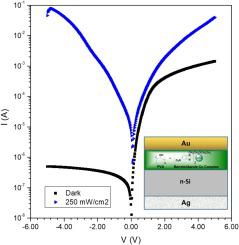Sensors and Actuators A: Physical ( IF 4.6 ) Pub Date : 2020-09-13 , DOI: 10.1016/j.sna.2020.112335 Muharrem Gökçen , Ersin Orhan , Songül Taran

|
Au/n-Si metal/semiconductor (MS) type diode was transformed into a metal/polymer/semiconductor (MPS) type diode by polyvinyl alcohol (PVA)+benzimidazole Cu complex interfacial layer to achieve better photodiode properties. Au/PVA + benzimidazole Cu complex/n-Si MPS diode's electronic and photo-responsivity (PR) properties were investigated by current-voltage (I–V) measurements under various ultraviolet (UV) (365 nm wavelength) illumination intensities (from 50 to 250 mW/cm2) and at room temperature. It was found that the difference between the dark and high UV illumination I(V) plots of the MPS diode exceeds 105 times. Thus, this higher response to UV illumination has caused the reverse region current of the diode exceeds the forward region current since the first UV illumination level (50 mW/cm2). This ensures both the MPS diode has a very high PR value and allows that the diode working direction can be adjusted with UV exposure. The remarkably high PR values were obtained for P = 100 mW/cm2 as 11.01 A/W at −4.84 V, and 2.14 mA/W at 0 V. Also, main electronic parameters of the MPS diode were calculated by thermionic emission, Ohm law, Cheung&Cheung and Card&Rhoderick methods. The series resistance (Rs) values calculated for each Cheung&Cheung function are compatible each other and there is an acceptable coherence with obtained values by ohmic approach. For the surface states density (Nss) of the MPS diode obtained for each UV illumination, it was found that they are higher than the dark ones and they shifted to lower energy region.
中文翻译:

高光响应性Au /聚乙烯醇(PVA)+二[1-(2-乙氧基乙基)-5-硝基苯并咪唑]二氯化铜/ n-Si UV光电二极管
通过聚乙烯醇(PVA)+苯并咪唑Cu配合物界面层将Au / n-Si金属/半导体(MS)型二极管转变为金属/聚合物/半导体(MPS)型二极管,以实现更好的光电二极管性能。Au / PVA +苯并咪唑铜配合物/ n-Si MPS二极管的电子和光响应性(PR)性能通过在各种紫外线(365 nm波长)光照强度(从50起)下的电流-电压(IV)测量进行研究至250 mW / cm 2)和室温。发现MPS二极管的暗和高UV照明I(V)图之间的差异超过10 5次。因此,这种对紫外线照射的较高响应已导致二极管的反向区域电流超过第一紫外线照射水平(50 mW / cm 2)以来的正向区域电流。这样可以确保两个MPS二极管都具有很高的PR值,并且可以通过紫外线照射来调节二极管的工作方向。对于P = 100 mW / cm 2,在-4.84 V时为11.01 A / W,在0 V时为2.14 mA / W,获得了非常高的PR值。此外,MPS二极管的主要电子参数是通过热电子发射Ohm来计算的法律,张祥和Card&Rhoderick方法。为每个Cheung&Cheung函数计算的串联电阻(Rs)值彼此兼容,并且通过欧姆方法获得的值具有可接受的相干性。对于表面态密度(N对于每个紫外线照射获得的MPS二极管的ss),发现它们比黑暗的二极管要高,并且它们移至较低的能量区域。

























 京公网安备 11010802027423号
京公网安备 11010802027423号